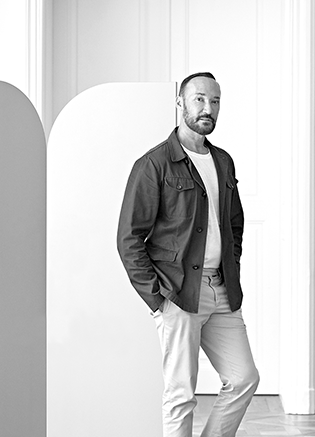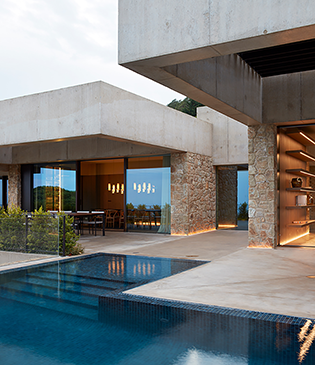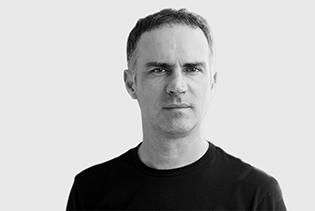Big Bird encapsulates LZF’s penchant for dreaming big and re-engineering the concept of what a lamp can be. Big Bird was first imagined by the artist Isidro Ferrer, and is made in collaboration with master artisan Manolo Martin.

The life-size Big Bird is built with a traditional craft technique used by Fallas artisans, known as vareta. Hovering hummingbird-like, with its fine wooden plumage, pointed beak, and hanging globe, Big Bird is an accomplished feat of wood craftsmanship, and a remarkable contemporary sculpture.

To celebrate the addition of the new horizontal Big Bird—it joins its vertical sibling—we had the pleasure of talking with Big Bird’s creators, Manolo Martin and Isidro Ferrer, two giants of Spanish craft and design.
Manolo Martin

Manolo Martin (with a model of Big Bird).
Big Bird is built with a traditional Valencian craft technique known as vareta. Can you describe this technique?
(MM) Vareta is woodcarving. It consists of reproducing a volume in wood: to achieve the form, the element is reproduced by using sections of it (called dogas), and the ‘skin’ is shaped by means of fine woods (varetas). The technique comes from the world of navigation and aeromodelling. To use a simile with the world of navigation (caulkers or shore carpenters), the ‘dogas’, made using birch plywood, are a ship’s ribbing. The ‘varetas’, made using elm, are the boards nailed to the ribbing, that make up the hull of the ship.

Today, we see a prevalence of mass manufacturing and new technologies in design. Many traditional craft techniques, such as vareta, have diminished or are extinct. Are master artisans an ‘endangered species’; how can they recover and endure?
(MM) In the field that most concerns me, wood craftsmanship, we have not become extinct, but we are in the process of extinction. This is because the work that was traditionally carried out by artisanal processes has been replaced by industrial processes. There is much more emphasis on quantity and productivity, than on the quality of the product. In order to deal with this, we need collaboration between design and craftsmanship. Design adds value to the product, and craftsmanship is a way of making a unique, higher quality product. Both have an excellent future together, and offer an alternative to the tedium of mass production. I am convinced there remain customers who appreciate this differentiation (and I see it day-to-day). A clear example is my long-standing collaboration with LZF Lamps.
Describe your relationship with your craft.
(MM) As a boy I was in love with my father’s workshop, but worried about the future offered by craftsmanship. I have worried about contributing a technical and more pragmatic component to that wonderful ‘artistic world’. I feel proud of having been able to contribute that ‘grain of sand’, ensuring the continuity of the great artisanal masters that surround me.
Projects such as Big Bird, Walking Fish, Koi, and Smelly Fant are unique. What do they each add to the world?
(MM) For me, Koi represents confidence in craftsmanship. It is the most pleasing example of everything I have fought for: a collaboration with the world of design, from zero to one hundred. Big Bird has proved to be a challenge, a difficult element to turn into a lamp, and a wonderful goal to fight for.

Walking Fish and Smelly Fant: DESIGN with CAPITAL LETTERS. Isidro Ferrer, an evident example of what I admire most in design, using a little to say a lot. Working on projects like Walking Fish and Smelly Fant, with professionals as brilliant as Isidro, is what makes me enjoy my work more every day.
Isidro Ferrer

Isidro Ferrer.
A few years back, LZF called and asked you to develop ‘something’, giving you the freedom to create an unspecified thing, without any preconditions: the result was Funny Farm. How did you realise the project and what inspired that quirky cast of characters?
(IF) LZF is a lighting company. Lighting is a beautiful word that underpins the craft of illustration. The light that a lamp throws generates a field of vision and makes the space that surrounds it possible; the light that an illustration provides illuminates the understanding. Behind LZF are Mariví [Calvo] and Sandro [Tothill]: they are people, they are friends, they are company. Company is another curious word. Beyond its link with the industry, the market, and its lucrative purposes, the word appeals to an action that requires decision.
The Funny Farm project, and its deviations, are thanks to Mariví, Sandro, and LZF Lamps. The uniqueness of the process is determined by the combination of these three qualities in one body: person, friend, company. Despite what design manuals say, an assignment does not necessarily arise from need; sometimes it does not even seek to find the solution to a problem. An assignment arises from a hunch or a whim. The Funny Farm project is born in a moment of shared joy, its development activated by complicity and trust.

Isidro Ferrer and the Funny Farm.
The Funny Farm project is not a commission—it is an invitation. An assignment entails carrying out tasks with a specific purpose. An invitation has no objective; it does not pursue any profitability. An invitation is a demonstration of affection and courtesy. The invitation is to carry out a new communication campaign for LZF. The briefing is the absence of it. There are no guidelines because there is no need. And without guidelines there is no direction. The absence of a map means that the route lacks a goal. The paths are all and none. The fear of freedom is born together with the invitation, and continues until the excitement of the process puts a gag on it. The first step is to draw a map, even if it is fictitious, and to name the first geographical features. Light and matter are obligatory places. Light becomes form, matter is wood. Attached to the shapes of LZF lamps, on the turned wood, the first figures are born. The animals arrive later, as a result of the expressed desire of each of these forms. Each one decides to be what it longs for: elephant, ant, goat or duck, hat or rabbit.
The project grows as it develops, as a result of the amazement. The animals appeal to the shapes of the lamps, and the lamps claim the animal presence with such insistence that they achieve their purpose. Elephant and Fish are illuminated. Later, Big Bird opens its wings and takes flight.
Eight years is the time that has passed between the invitation and the present.
Your work features an extensive use of characters and symbols, many of which have certain peculiarities. What is your creative process?
(IF) The continuous systematization of the processes of creation eliminates the surprise and kills the unheard of. Therefore, as a system of confrontation to the ‘method’ that proposes an ordered and systematic way of proceeding to reach a result, I propose the opposite: an ‘ametodológia’ of the disorder, a harmonic chaos that enhances the unpredictable.
What are you curious about?
(IF) I am interested in astonishment and emotion. Not to provoke astonishment and emotion in others, something that would be pretentious on my part, but that this astonishment and emotion be latent throughout my work process.
The life-size Big Bird follows in the footsteps of the life-size Walking Fish and Smelly Fant. How do you conceive something that grand and complex, and make it a reality?
(IF) Mariví and Sandro are to blame for this ‘gigantization’. They have a unique spatial and scenographic vision, and are responsible for the fact that in this project, I went outside my natural scale. The result is reality thanks to the skill and knowledge of Manolo Martín, the Fallas artist who made it possible.

You work with ‘any medium, any technique’. You have a passion ‘for the theatre of life.’ In what ways can art and design make the world a better place for all?
(IF) One of the characteristics of art is its uselessness; art, by definition, lacks function. But, as the writer Grassa Toro points out: although ‘art is useless, a work of art can be useful for almost anything’, even for making the world a better place. On the other hand, the main characteristic of design is its character and functionality. If we pay attention to French designer Abraham Moles’s definition of design, in which he wants to ‘intervene in the human environment, to adapt the environment to the needs of individuals or groups of individuals’, we will realise that the essential purpose of design is that: to make the world a better place.
The making of Big Bird
Images of Big Bird at various stages in the making. Photographed at Manolo Martin’s workshop.






















